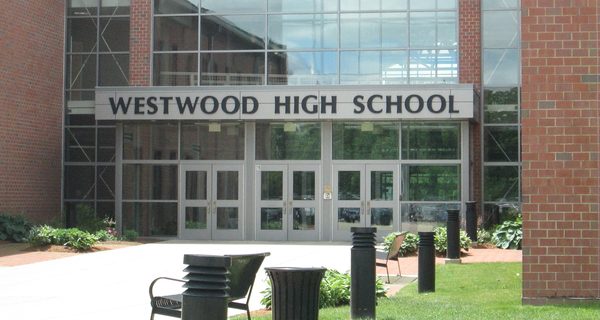By James Kinneen
Hometown Weekly Reporter
On Thursday night, the Westwood School Committee met to both announce the results of collective bargaining with the teacher’s association regarding the fall school reopening, and to decide whether they would allow teachers' children to attend school in person four days a week.
Superintendent Emily Parks first noted that as of Thursday afternoon, she had reached a tentative agreement with the Westwood Teacher’s Association on the previously outlined fall reopening plan. The next step would be for the school committee to review the memorandum of the agreement and vote on it, while the WTA leadership present the memorandum to their members and votes on it from their end.
Currently, the plan of school opening is for pre-K, kindergarten, grades one, two, three, six, nine and twelve to begin in-person schooling during the week of September 14, while the other grades attend remotely. During the week of September 21, grades four, seven and eleven would join in-person school. And, during the week of September 28, grades five, eight and ten would join as well; by late September, all Westwood children would be in school on the days their cohorts were to physically report to the classrooms.
It was also announced that the schools will use an app called “School Dismissal Manager,” within which there will be a checklist of COVID symptoms. Parents will be required to screen their kids every day using this app, attesting that they have done so and that their children are symptom free.
As for the kids who opted to go fully remote, according to Superintendent Parks, it looks like Pre-K and kindergarten will be combined as one cohort. Grades one and two will have their own fully remote cohorts which will be taught by Westwood teachers, but may draw students from more than one elementary school.
Fully remote students in middle school will also be taught in fully remote cohorts, with Thurston Middle School teachers educating them. As for the other grades, the remote students will be virtually attending classes the same way all the other students do, during their cohort’s at-home learning days. Essentially, in high school, fully remote students will be constantly in the cohort that is remote on that day of the week.
As far as masks go, Westwood will be sending a clear explanation to parents of what constitutes an acceptable mask, which will include the message that neck gaiters, bandanas, and face coverings with valves will not be acceptable. Kids with medical exemptions will be allowed to not wear masks, however Westwood is still working on the procedure of how parents should get doctor’s notes to them. Currently, the plan is to receive them through student services, because a doctor’s note about the medical exemption is considered a confidential student record.
As for the public comments, outside of the usual arguments about whether school should be fully in-person or fully remote, one issue kept coming up. People were looking for concrete guidelines and specific numbers that would determine when Westwood would either be safe enough to transition to fully in-person school, or unsafe enough to have to transition to being fully remote.
While the town comments are not supposed to be answered, Carol Lewis of the school committee did take the time to note: “I want folks to know that we will continue to work with the Department of Public Health. We will be watching what happens in the community. We’re looking for trends. And we will review the data weekly with Public Health.”
But the main issue of the night concerned whether Westwood would approve the DESE guideline that children of teachers be allowed to attend in-person class four days a week. Superintendent Parks noted that she has looked at the numbers and thinks it’s feasible for Westwood, up to grade six - beyond that and it would become tricky to maintain six feet of social distancing. The hope is that beyond grade six, people would hopefully need less childcare, since the students in question would be older.
Parks argued that she wanted Westwood to pass the motion, but her motivation wasn’t so much looking to help out teachers, it was her wanting to avoid having to hire substitute teachers, acknowledging she’d legally have to provide twelve weeks of leave if someone needed childcare due to COVID-19, and because it “would allow us to work through what frankly are some very significant challenges in terms of our staffing model right now.”
“I have to say that my discussion tonight isn’t even about how we can support teachers - of course I want to do that - but I think I’m making a very pragmatic argument tonight, which has to do with our responsibility to the kids in our classrooms, and how we provide effective instruction for them, how we ensure that our staff is in place," Parks explained. "If it has the benefit of helping somebody, then I’m glad, but what I’m saying is from a pragmatic perspective, I think that we need to do this in concert with other districts to make sure schools are able to function and operate with the staff we need in the rooms.”
Many of the public comments concerned the unfairness of essential workers needing to find their own childcare with school being out, while teachers’ kids get to go to school four days a week (they wouldn’t go on the day both cohorts are remote). Those people would likely appreciate Charles Donahue, who asked that if the committee was going to gauge how many teachers would be using this option, if they couldn’t at least explore some type of system to help residents, especially first responders, who really need childcare.
Carol Lewis quickly disagreed, arguing: "I think in this pandemic everybody has an issue, everybody is struggling, and we can’t possibly make this hybrid work if we, as much as we’d like to, reach out to everybody and provide them the opportunity to go four days a week. That will completely turn the hybrid model on its head, and we won’t be able to maintain the six-foot distancing. This is a staffing concern. If we don’t have the teachers in the schools, we’re not going to have schools.” Lewis then summarized: “I would respectfully say to you that I don’t think we could go down that road right now.”
This option will also not apply to people who work in Westwood Schools, but are not members of the teacher’s association. When asked if the rule would apply to janitors and school nurses who are vital to the hybrid model, Parks declared: “At this point, it would be open to teachers, and I include in that other members of our teachers association, like nurses. Unfortunately, I don’t think we have the capacity to expand it to other folks - instructional assistants, for example. We’re not able to do that and meet the parameters of the hybrid model.”
The motion passed unanimously, with the caveat that it is based upon Superintendent Parks doing the research and finding the numbers to be reasonable.






















